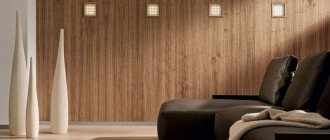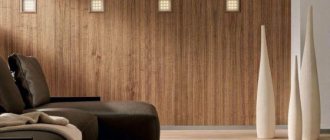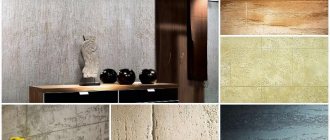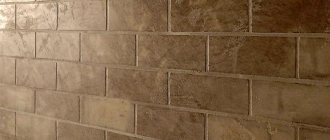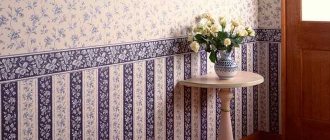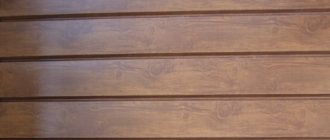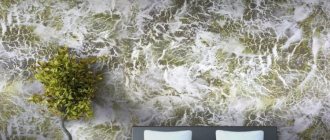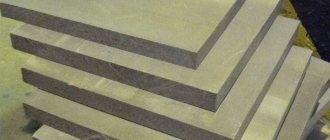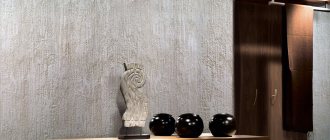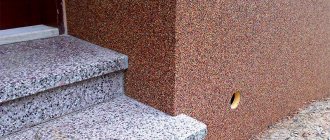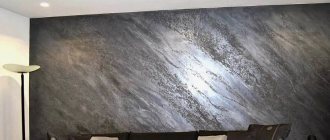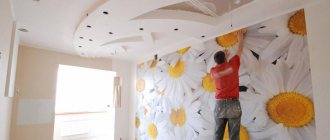Throughout the history of mankind, there was a tree next to it, which man used to build housing and for its decoration. It has a unique texture, the pattern of which does not tire the eye. When the boards are placed horizontally, their lines make the room visually wider, and when placed vertically, they make the room taller. However, natural wood cladding may not always be an affordable option for a family's budget. As in other similar cases, imitation became a way out of the difficulty. Decorative plaster imitating wood indoors and also on the facade of a house can imitate wooden cladding of a large area or individual decorative panels. This is done in different ways.
Types and applications
Using decorative plaster, you can achieve various effects related to texture:
- tree bark,
- surfaces eaten away by woodworms,
- boards laid closely
- wooden panels,
- cross cut.
Textured wood-look plaster requires compositions that do not contain fibers or large inclusions. These are mostly smooth mixtures. Decorative plaster is made from mixtures with fine filler, looking like tree bark. The exception was structural bark beetle plaster with granules from 2 mm.
Wood-like plaster finishing is used in interiors in the form of wooden panels in the hallway, corridor or in other rooms. Such coverings look great on loggias and balconies, in the decoration of facades or small architectural forms (gazebos, walls, etc.), fences and even paths. Surfaces that imitate bark or wood cuts look advantageous in various interior styles.
Before working on the wall, practice on sheets of plasterboard, fiberboard or plywood.
The imitation wood made by professionals is very close in texture to natural wood. In fact, decorative wood-look plaster can be successfully done with your own hands and by those who are still new to the plaster business. It's all about the desire to learn, practice and the desire to achieve high quality.
Varieties
The composition of the plaster mortar includes solid components, which, when rubbed, form characteristic grooves. The color and type of cladding obtained are indicated on the packaging. Structural and textured varieties, which are divided into subtypes, are popular.
Bark beetle
This is a structural composition that requires skill in application. Not suitable for restoration, there are seasonality restrictions. The advantage of this type is the light weight of the coating due to the mineral chips in the composition. Does not load the wall, the surface after application of the coating is without deformation.
The mixture is environmentally friendly, safe for health, resistant to sudden changes in climatic conditions , direct sunlight, high humidity, and mechanical damage. The plaster is impervious to the formation of mold and mildew and is durable. You can create different color combinations.
Wood panel
Volumetric plaster looks like modeling patterns based on wall finishing materials. Advantages: strength, lightness, resistance of the material to damage and temperature changes. You can create unique compositions to enhance the beauty of your interior.
Advice
Wood panels easily mask serious defects and surface imperfections.
But this mixture is not used for exterior decoration, as it takes a long time to dry and reacts to changes in external weather conditions.
Oak bark effect
Durable cladding looks great in a gazebo, on a loggia, it can be used to create designs on fences and decorate facades. Advantages: durability, resistance to precipitation and temperature changes. Amenable to restoration, masks base defects. Has the ability to “breathe”. This is an environmentally friendly, safe material that is completely harmless to health.
Imitation of cross cut
A very unusual way to imitate wood.
Important
The finishing is expensive, it looks very rich in appearance.
In addition to all the previous advantages, the coating ideally hides unevenness and masks imperfections. But there is also a minus: the transverse cut of wood cannot be restored.
What's so good about this finish?
The main advantages of this type of finishing (compared to natural wood) are lower cost and greater durability. Decorative plaster for wood:
- doesn't rot
- withstands temperature fluctuations,
- resistant to precipitation,
- does not burn,
- can be renewed by coloring,
- hides minor flaws,
- "breathes"
- environmentally friendly
The best manufacturers
Based on customer reviews and expert assessments, a list of the best manufacturers of decorative plaster imitating tree bark was compiled:
- Kerezit.
- Perfecto.
- Tikurilla.
- Bayramiks.
These are ready-made mixtures with fillers of different size fractions, which are suitable for beginners and professionals. The compositions are odorless, easy to apply and rub in, which reduces work time.
Suitable for preventing cracks, they perfectly protect walls from fungal infections and mold, as they have water-repellent properties. They can be diluted with plain water. There is no need to use chemical fillers or solvents, since all these components are already added to the solution in the required proportions.
Materials used and preparation for application
Compositions on various bases can be used as textured wood-look plaster: acrylic, mineral, silicone. These are mainly smooth mixtures or with fine-grained filler, for example, decorative plaster Marmorino tree bark. To obtain the bark beetle effect, structural compositions are used. Often, decorative plaster imitating wood is done by home owners with their own hands, and from materials made independently. For example, they can imitate wood even using ordinary putty.
The work does not require colored mixtures, since the coatings, after completing the formation of the texture, are painted and protected with wax or varnish. As a result, decorative plaster is obtained to resemble valuable or aged wood, as needed in a particular interior.
Achieving an antique plaster effect has become increasingly popular lately.
This type of finishing can hide minor flaws and flaws in the base surface. However, in all other respects it requires the same preparation of the base as other types of coatings. Only in this case can a long, multi-year service life be achieved.
Prepared base:
- cleared of remnants of the previous finish,
- if necessary, leveled and repaired,
- removes stains and traces of grease,
- primed,
- dried thoroughly.
If the surface of the base does not hold the coating well (for example, paint or foam), be sure to install a reinforcing mesh.
Necessary tools (trowel, brushes, trowel, rubber rollers)
Plastering the surface is carried out in three stages:
- Leveling the wall.
- Applying a decorative layer.
- Creating a drawing.
Each process requires its own set of tools.
Surface preparation:
- containers for preparing cement mortar;
- hammer drill with mixer attachment;
- bucket for pouring mortar;
- rule for leveling the rough layer;
- a small spatula to remove residual mortar;
- trowel for finishing leveling.
Applying plaster:
- container for preparing decorative composition;
- construction mixer and hammer drill with attachment;
- wide spatula;
- smoothing iron;
- plastering and grouting trowel.
Creating patterns:
- plastic grater to create a “bark beetle” effect;
- rubber rollers with a pattern;
- ready-made stamps for imprinting a design.
Attention
The list of tools can be modified in accordance with the technology for laying a particular type of plaster.
Technology and application methods + video
Bark of tree
As an example of how decorative plaster with the effect of wood bark is made, let’s take a finish made from the least expensive materials.
- The working solution is prepared from gypsum plaster. The purchased dry mixture is diluted in water.
- The solution is applied to the prepared base using a trowel in an even layer of 2-3 mm.
- The initial relief is immediately applied with a roller moistened with water.
- When (after 20-30 minutes) the surface of the plaster dries a little and does not sag when pressed lightly, it is moistened with a spray bottle and the protrusions begin to be smoothed. This is done with a spatula so that after it passes between the smooth areas, ruts remain - deepening cracks in the bark. After each long smoothing movement of the spatula, wipe it with a damp cloth so that the lumps of solution remaining on it do not spoil the surface.
- The surfaces are allowed to dry completely (usually a day). After drying, small flaws that can be scratched are removed with a spatula.
Wax is usually used for the protective layer of decorative plasters. In this case, it can be replaced with non-woven glue mixed with water-soluble acrylic varnish. The glue is diluted, brought to readiness, and mixed with varnish in a ratio of 1:0.5. Then the selected color is added and after stirring, the “budget wax” can be used. It is applied with a trowel. With this application, all the depressions are filled and the surface is smoothed. Excess is removed with a damp sponge, and the surface is smoothed again with a trowel. This type of finish can be varied in various ways, for example, you can apply a little paint of a different tone with a sponge.
Technology for modeling wood texture on plaster
Before modeling the texture of wood on plaster, you need to wait half an hour until the surface of the mixture dries. You need to prepare your tools in advance, maybe a spatula, to display the pattern of natural wood on the relief.
After the plaster has dried, you need to apply the solution to the matrix in the ratio specified in the requirements for the mixture, and distribute the lubricant evenly over the surface of the wall. Carefully roll over the layer with a rubber roller to imprint the wood pattern. From time to time the matrix needs to be changed sides, this is done in order to create a realistic look of the wood pattern, thus the pattern does not repeat itself, but changes the structure.
After the façade plaster has dried, sharp edges are removed using paper. You need to thoroughly clean the surface from any imperfections and dust; this action is done before impregnating the colored solution, which will add volume to the pattern on the wall. The colored solution is applied only after three days, after all the plaster has dried. The mixture must be applied with a brush; painting occurs in a double layer with a break of a day between applications.
Coloring
Of course, creating texture is the most labor-intensive task in wood finishing. However, painting the plaster is the final stage of finishing. Therefore it must also be of high quality.
Before painting, a primer is applied to the surface with a brush along the wood lines, colored in the desired tone. The dye used is water-soluble.
The best way to convey the richness and depth of the natural color of wood is with translucent compounds, applying layer after layer of compounds of different shades. To obtain a budget coloring composition, you need to mix sequentially (with stirring after adding each next component) the following components:
- a little primer
- color scheme of the desired tone,
- white water-based paint,
- some dry wallpaper glue.
The mixture is applied with a brush, following along the fibers. Excess mixture is removed with a rubber spatula. After this base layer has dried, you can apply a composition with a different shade. The paint for subsequent layers is made without wallpaper glue and primer - only water-based emulsion with dye.
There are many options for coloring and coloring compositions. Here, as they say, dare and create. Just try it first on “experienced plots”.
Advice from the experts
Beginners are not always able to create a professional and attractive decorative layer of plaster. The reasons are reluctance to follow manufacturers' recommendations, take into account the unique properties of a particular composition, impatience and carelessness.
The following expert tips will help you avoid basic mistakes:
- Proper storage of material. If you place the plaster in a cold, damp place, it will quickly deteriorate. The frozen mixture is very difficult to apply.
- During storage, avoid drafts and high temperatures. The plaster will lose its ductility and strength.
- Use only high-quality tools and clean containers, rollers, and brushes. Otherwise, foreign particles will get into the general composition and become fixed on the surface.
- Strict adherence to the manufacturer's instructions. Be sure to observe proportions when diluting, drying time, and additional nuances of use. A competent approach will affect the quality of processing and extend the service life of the finished surface.
- Before applying the plaster layer, you should do several test paints. This will determine the accuracy of the shade, application conditions and drying time.
- After finishing the work, the new plaster layer can be washed with various detergents and plain water.
AdviceIf a high-quality mixture was purchased, then cleaning will not harm the layer in any way.
- Use colors from the same manufacturer as the plaster. There is a possibility of damaging the base material with dangerous dyes.
Decorative plaster is a modern and beautiful material that exists in several varieties. It is difficult to apply, but patience and a competent approach will turn the work into an exciting process. Taking recommendations and advice into account will affect the quality, strength, durability and attractiveness of the final result.
Imitation of wood using polymer clay
The texture of the clay resembles plasticine in appearance. Thanks to the variety of shades and reasonable price, it is gaining popularity as a universal finishing material. Sold in small rectangular pieces. The advantage of the method is the ability to obtain the desired structure without the use of coloring compounds.
Sequencing
The order of working with clay is as follows:
- First you need to take several types of material and cut the same piece from each.
- Each piece is kneaded and a sausage is formed from it.
- Next, the sausages are divided into several slices and mixed together.
- Several different pieces (4-5 pieces) are connected together and balls of a uniform shade are obtained.
- The balls are rolled into thin slices and placed in a pack.
- The edges of the resulting stack are cut off and cut into two parts.
- The two halves are placed on top of each other and rolled. This procedure must be done several times.
- The resulting layer is cut into strips 3 mm thick and connected to each other.
- The strips are laid out with the cuts facing up and rolled out until the required imitation is obtained.
Pallet boards
This method—disassembling pallets into boards and decorating a wall with them—struck our imagination so much with its effectiveness and cost-effectiveness that we wrote a detailed master class about it: “Do-it-yourself wooden accent wall: master class.”
What you will need:
pallets, sandpaper, stain, nails, antiseptic, tools.
Price:
very low - only the price of consumables, pallets can be found for free.
Who to entrust:
easy to do yourself.
Florentia / Florence
Decorative coating that imitates balsa wood or the “bark beetle” effect on the wall. This effect is achieved with the help of solid mineral particles contained in the plaster. Depending on the application, the pattern of grooves can have a variety of shapes - both unidirectional and “world map”
| Packaging (kg) | Area (sq.m.) | Price, rub.) |
| 1 | 1 | 387 |
| 5 | 5 | 1660 |
| 25 | 25 | 6279 |
Decorative coating that imitates balsa wood or the “bark beetle” effect on the wall. This effect is achieved with the help of solid mineral particles contained in the plaster. Depending on the application, the pattern of grooves can have a variety of shapes - both unidirectional and “world map”
Application method
Application area
Used for interior work. The individual features of this plaster give the finished surface a rare, classic look, while guaranteeing the cleanliness and safety of the structure from an environmental point of view.
Advantages
Warranties and storage conditions
Storage temperature: +5°C to +35°C Application temperature: +5°C to +35°C Shelf life in unopened original packaging: 24 months
Specifications
Turning metal or plastic into wood is easy
In the photo – KAOWA SEMENTOL – “liquid wood”
On the Internet you will find many videos in which professional artists, using special brushes, foam swabs and other means, recreate the texture of wood on various objects. After varnishing, objects finished in this way are practically indistinguishable from their wooden counterparts.
Stock up on the necessary tools, patience and try to do something like this. Unfortunately, you most likely will not be able to draw the texture of wood by hand. But don’t despair, there is a way out - this is a special paint that imitates the structure of wood.
For example, in some specialized stores you will find paints and varnishes presented by the KAOWA SEMENTOL brand. On cans of these products you will see such designations as “mahogany paint” or oak, ash, teak, etc.
That is, these paints and varnishes make it possible not only to imitate the arrangement of wood fibers on certain surfaces, but also to reproduce the texture of valuable or exotic wood species. This advantage is especially important when decorating furniture and other elements of the surroundings.
Scope of application
The photo shows a variety of paint colors that imitate wood texture
Special paints and varnishes, sold as liquid wood paint, are intended for treating various surfaces with high and medium density. These coatings can be used both for interior finishing work indoors and for exterior finishing.
The paint can be applied with equal success to wood, plastic, metal, ceramic, glass and other substrates with a matte, smooth and glossy surface. Specialized paints to imitate wood texture do not contain wood-based fillers and are therefore resistant to the negative effects of environmental factors.
As already mentioned, the use of special compounds is important when decorating furniture and other elements in the interior with your own hands.
These paints are widely used in workshops involved in improving car interiors. Thanks to special paints and varnishes, unpresentable plastic dashboards, lids of various boxes and other surfaces in the car can be made “wooden”.
Despite the fact that the price of paints and varnishes that imitate the texture of wood is several times higher than the cost of traditional enamels, this method is still more affordable than paying for the services of a professional artist.
Features of applying “liquid wood”
The use of special paints and varnishes is no more difficult than ordinary painting of wood. But there is one condition: you must use the right tool: a hard, flat brush based on natural bristles.
The length of the bristles determines how pronounced the texture of the wood will be. That is, if you need the fibers to be well drawn, use a brush with short bristles. The longer the bristles, the more poorly defined the texture will be.
The paint is applied directly from the can without special preparation and without the use of solvents. It is necessary to decide in advance on the required color, since it will not be possible to change the tone or color of the paint during application.
Important: Special paint designed to imitate wood is not mixed, but only shaken immediately before opening the can.
It is necessary to prepare the surface before decorating in the same way as before applying any paints based on organic solvents. That is, the base is cleaned of unevenness and dirt, primed and only then painted.
If a glossy finish is being decorated, it should be matted with zero sandpaper to ensure maximum adhesion.
Forming veins with a hard brush
The paint is applied in long stripes from one edge of the product to the other. You should not rub the applied layer, as is done with conventional coatings, as the texture of the imitation wood fibers will be damaged. A shiny film appears literally 15 minutes after application, and complete drying occurs in 1-3 hours, depending on temperature and humidity.
According to people who have used KAOWA SEMENTOL in accordance with the instructions indicated, the finished coating is an order of magnitude superior in quality and similarity to cut wood.
How to make a wood-look spatula with your own hands
It is not advisable to buy special spatulas, especially if you only need to treat small areas. You can make the necessary devices from ordinary plastic or improvised materials.
To cut a tool from a plastic lid from a paint or putty container, you need to draw the contours of a spatula and cut with sharp scissors. In total you will need 3 parts of different sizes:
- wide, on which large notches are formed with a stationery knife;
- medium, small teeth are cut on it;
- narrow, its working edge is left smooth.
Using a knife, you can also form notches on ready-made plastic spatulas.
Rollers are also used instead of a spatula. So that they leave a mark on the surface similar to the pattern of a tree or bark, they are wrapped with threads of different thicknesses in any direction,
